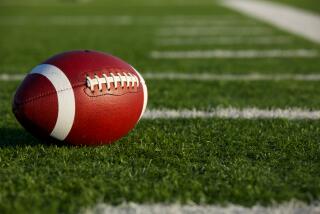Brain-Dead Player to Have Organs Harvested
- Share via
Matt Colby, a senior at Costa Mesa High rendered brain dead from an injury in a football game on Friday, was scheduled to have his organs harvested at midnight Saturday and to be disconnected from the life support system early today at UCI Trauma Center in Orange.
Colby, 17, suffered a fatal brain injury when he was blocked to the ground on kickoff coverage in the first quarter of Costa Mesa’s 53-12 victory over Huntington Beach Ocean View. Coaches were informed after the game that Colby, who played for three seasons at Costa Mesa Estancia, had lost brain activity and was breathing with a respirator.
He is the second player in the nation to reportedly suffer a fatal injury during a high school football game.
“His family and I have agreed that Matt would want us to donate his organs so that maybe he could save someone else’s life some day,” said Colby’s mother, Kelli, in a statement Saturday. “The outpouring of love and support from Matt’s coaches, friends from both Estancia and Costa Mesa High schools, family, friends and my co-workers has been overwhelming.”
Colby, a 6-foot, 185-pound linebacker, was among five players who transferred from Estancia to rival Costa Mesa to play for Dave Perkins, former coach at Estancia.
Perkins, school Principal Diana Carey, a Costa Mesa police chaplain and a school district psychologist spoke at the team’s weekly 11 a.m. meeting Saturday, where about 150 players, cheerleaders, boosters and teachers were told the severity of Colby’s condition. The football team then met privately after the 40-minute group meeting. Players declined to speak with reporters.
Carey postponed this week’s homecoming activities, and said the team will determine, probably Monday, if it will play its game Friday against Whittier Christian.
“I’ve lost both my parents, and I feel as big a void, if not bigger, than when I lost them,” said Perkins, who coached Colby for four years and whose son, A.J., was best friends with Colby.
At the Estancia football game Saturday night against Santa Ana Valley, Colby was remembered by a group of cheerleaders, who decorated banners and brought an enlarged picture of Colby in an Estancia uniform. Eagle players rushed through the banner before kickoff.
Most surprising to those in the football program was how nondescript the play that injured Colby was.
He was involved in kickoff coverage about four minutes into the game and was blocked to the ground by an opposing player. He remained in the game for two defensive plays at linebacker, but was not involved in any significant action.
Colby then left the field and complained that his head hurt. He also told a trainer that he felt tingling in his feet and legs.
“It was a normal football hit, it wasn’t a devastating thing, but you could tell something was wrong when he came off the field,” Perkins said.
On the sideline, Colby collapsed and lost consciousness, according to Carey. Colby’s condition worsened as paramedics arrived.
“It turned bad very quickly,” Perkins said. “It was unbelievable.”
Perkins said the only previous injury Colby had was on Sept. 15, when he said Colby had a headache after the Westminster game.
*
Described as quiet, popular, hard working and a good student, Colby was “a typical high school football player, with a big heart who gave it everything he had,” Perkins said.
Game-related football deaths have been rare in the Southern Section.
Dean Crowley, retired section commissioner who has been involved in high school sports for more than 40 years, said he thought there were no more than four game-related deaths the last quarter century.
The most recent high school player to die from a game-related football injury was Brandon Wade of Buckeye Valley High in Delaware, Ohio. Wade died Sept. 15 of head injuries suffered in a game on Sept. 7.
In 2000, three athletes in high school and junior high died from football-related injuries , according to the University of North Carolina’s National Center on Catastrophic Sports Injury Research.
More to Read
Sign up for Essential California
The most important California stories and recommendations in your inbox every morning.
You may occasionally receive promotional content from the Los Angeles Times.












